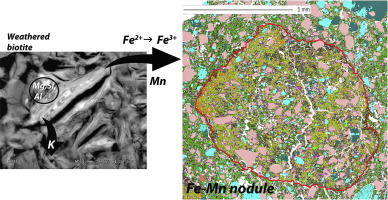当前位置:
X-MOL 学术
›
Appl. Clay. Sci.
›
论文详情
Our official English website, www.x-mol.net, welcomes your
feedback! (Note: you will need to create a separate account there.)
Origin and paleoenvironmental significance of Fe Mn nodules in the Holocene perialpine sediments of Geneva Basin, western Switzerland
Applied Clay Science ( IF 5.3 ) Pub Date : 2018-08-01 , DOI: 10.1016/j.clay.2018.01.027 Branimir Šegvić , Stéphanie Girardclos , Giovanni Zanoni , Carlos Arbiol González , Tara Steimer-Herbet , Marie Besse
Applied Clay Science ( IF 5.3 ) Pub Date : 2018-08-01 , DOI: 10.1016/j.clay.2018.01.027 Branimir Šegvić , Stéphanie Girardclos , Giovanni Zanoni , Carlos Arbiol González , Tara Steimer-Herbet , Marie Besse

|
Abstract Perialpine areas of central Europe have undergone significant changes following the last Alpine glaciation and especially through the Holocene time. This study relies on geochronological, mineralogical and geochemical clues to explain the formation and paleoenvironmental significance of Fe Mn nodules reported from the young soils (~4.5 ka BCE) of Geneva Basin in western Switzerland. Having on average 2 mm in diameter, the nodules usually possess an onion-like and quasi-layered internal architecture defined by selective enrichments in Fe and Mn. Fe-rich mica is largely present in soil matrix and has served as a main source of Fe and Mn. Susceptible to favourable Eh-pH conditions several steps in mica weathering were recognised leading to the formation of nodules – vermiculitization, microcracking, Fe Mn segregation and re-precipitation. Mineral alterations were boosted by long periods of summer warm climate during Boreal and Atlantic times as suggested by the increasing illite-smectite content and a disappearance of hydroxyl-interlayered clays from analysed colluvium. Moreover, archaeological ages and radiocarbon dating of charcoal yielded coherent Fe Mn encrustation ages (4.8–4.3 ka BCE and 4.5–4.4 ka BCE, respectively) that coincide with the Holocene temperature maximum (~4 ka BCE) in Central Europe. Terrain morphology that led to better water retention formed earlier than ~8 ka BCE ago, during undefined Late Glacial time, promoting seasonal changes in redox conditions, thus facilitating the mobilization, distribution and re-precipitation of Fe and Mn. Established conditions lasted until Late Neolithic (3.4–2.2 ka BCE) when different agricultural practices changed favourable hydromorphic environment effectively putting an end to further nodule formation.
中文翻译:

瑞士西部日内瓦盆地全新世近高山沉积物中铁锰结核的成因及古环境意义
摘要 末次高山冰川作用后,尤其是整个全新世时期,中欧周缘地区发生了显着变化。这项研究依靠年代学、矿物学和地球化学线索来解释从瑞士西部日内瓦盆地的年轻土壤(公元前约 4.5 ka)报道的铁锰结核的形成和古环境意义。结核的平均直径为 2 毫米,通常具有洋葱状和准分层的内部结构,由铁和锰的选择性富集定义。富含铁的云母主要存在于土壤基质中,是铁和锰的主要来源。由于易受有利的 Eh-pH 条件影响,云母风化过程中的几个步骤被认为会导致结核的形成——蛭石化、微裂纹、铁锰偏析和再沉淀。正如伊利石-蒙脱石含量的增加和分析的崩积层中羟基夹层粘土的消失所表明的那样,在北方和大西洋时期,长时间的夏季温暖气候促进了矿物的改变。此外,木炭的考古年龄和放射性碳测年产生了连贯的铁锰结壳年龄(分别为 4.8-4.3 ka BCE 和 4.5-4.4 ka BCE),与中欧全新世最高温度(~4 ka BCE)一致。导致更好保水的地形形态早于约公元前 8 ka 之前形成,在不确定的晚冰期,促进氧化还原条件的季节性变化,从而促进铁和锰的动员、分布和再沉淀。建立的条件一直持续到新石器时代晚期(3.4-2.
更新日期:2018-08-01
中文翻译:

瑞士西部日内瓦盆地全新世近高山沉积物中铁锰结核的成因及古环境意义
摘要 末次高山冰川作用后,尤其是整个全新世时期,中欧周缘地区发生了显着变化。这项研究依靠年代学、矿物学和地球化学线索来解释从瑞士西部日内瓦盆地的年轻土壤(公元前约 4.5 ka)报道的铁锰结核的形成和古环境意义。结核的平均直径为 2 毫米,通常具有洋葱状和准分层的内部结构,由铁和锰的选择性富集定义。富含铁的云母主要存在于土壤基质中,是铁和锰的主要来源。由于易受有利的 Eh-pH 条件影响,云母风化过程中的几个步骤被认为会导致结核的形成——蛭石化、微裂纹、铁锰偏析和再沉淀。正如伊利石-蒙脱石含量的增加和分析的崩积层中羟基夹层粘土的消失所表明的那样,在北方和大西洋时期,长时间的夏季温暖气候促进了矿物的改变。此外,木炭的考古年龄和放射性碳测年产生了连贯的铁锰结壳年龄(分别为 4.8-4.3 ka BCE 和 4.5-4.4 ka BCE),与中欧全新世最高温度(~4 ka BCE)一致。导致更好保水的地形形态早于约公元前 8 ka 之前形成,在不确定的晚冰期,促进氧化还原条件的季节性变化,从而促进铁和锰的动员、分布和再沉淀。建立的条件一直持续到新石器时代晚期(3.4-2.











































 京公网安备 11010802027423号
京公网安备 11010802027423号